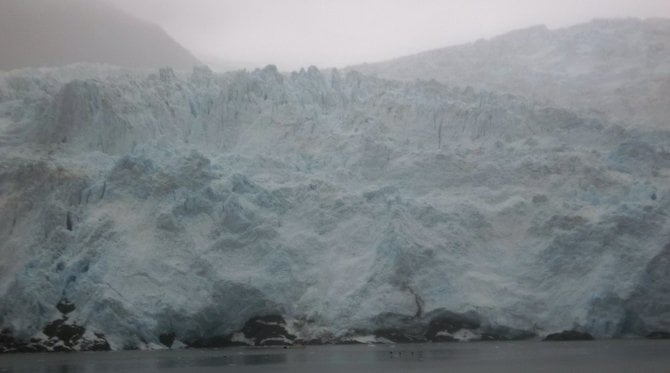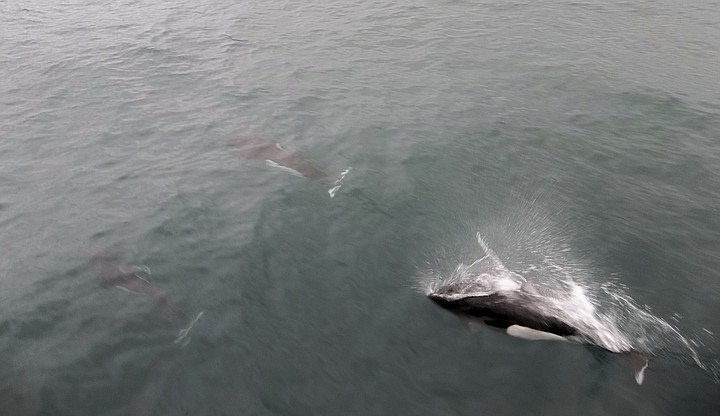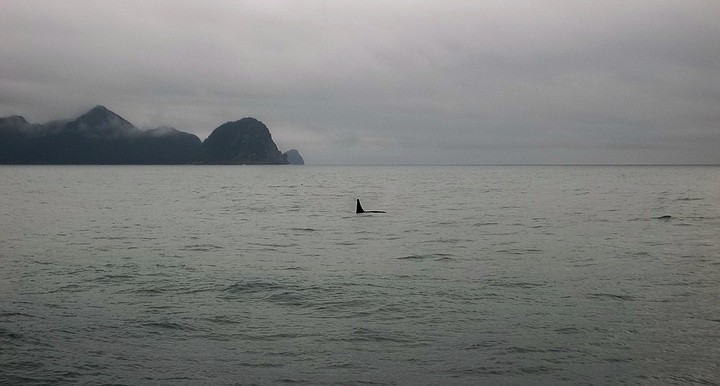 Facebook
Facebook
 X
X
 Instagram
Instagram
 TikTok
TikTok
 Youtube
Youtube

“Listen to the glacier talking to itself,” our guide urged us.
I listened to what sounded like thunder in the distance, followed by cracks and pops as if someone was breaking a gigantic stick. A chunk of ice fell into the icy water. The dramatic process of a glacier calving was occurring before our eyes and ears.
We were in Resurrection Bay off the coast of Seward, Alaska, in the Kenai Peninsula. The bay adjoins the 100-year-old port town of Seward, described for years as the “gateway to Alaska.” The Alaska Railroad connected it to the interior of the state, key to the development of Alaska. Seward is now known as the gateway to Kenai Fjords National Park.
We left Seward’s bustling harbor on a small cruise ship about 8 a.m. Our six-hour trip into the bay revealed quite a bit of marine wildlife along with one impressive glacier, the Holgate. On the sea and along the fjords, we saw puffins, orcas, bald eagles, humpback whales, harbor seals and sea lions.

I was most enraptured by a pod of Dall's porpoises (pictured). They swam rhythmically in front of our ship as if escorting or guiding us to our destination. It was mesmerizing – spiritual, even – to watch them hop through the water in groups of three or four as they seemed to form a bond with the boat.
Eventually, we came to the Holgate Glacier, a huge block of ice that appeared light blue under the overcast sky. We looked out at the glacier and listened to its sounds. As I listened to the glacier calving, I couldn’t help but think about the drought, fires and temperature spikes that inundated the country throughout the summer. Nature was at work, but was climate change as well?

We moved on. A humpback whale briefly appeared above the water before heading back under. Soon we saw an orca as well. A frenzy of small birds, kittywake gulls, swooped over the water, signaling there was a cluster of fish at hand. A bald eagle stood on a rocky ledge majestically overlooking the scene, waiting for an opportunity to intercede. I was mesmerized by this ecosystem that I had little familiarity with.
Seward is about a five-hour drive or train ride south of Anchorage. The highway and rail follow virtually the same route, revealing some of the most magnificent scenery on the continent.
The Kenai Peninsula, in the south-central section of the state, offers many of the most attractive qualities of the state in a relatively compact area. There are opportunities for fishing, boating and rafting in lakes, rivers and bays beneath thick forests and towering snow-capped peaks.
If you are without a car in Seward, there’s little problem getting around; most spots within the town are within walking distance. From Seward, you can catch a cruise or rent a kayak. A visit to the Kenai Peninsula just cries out a trip onto the water.
The Exit Glacier, just outside Seward on the edge of the Harding Icefield, is also a worthwhile visit – particularly if you have yet to see a glacier on your Alaskan journey. You can take a shuttle there from downtown Seward or drive to the visitor’s center, about a 45-mile walk from the glacier.
As you approach the visitor’s center you'll see signs appear intermittently with years on them, beginning with 1815. The signs indicate the spot the glacier reached that particular year, tangible evidence of the extent the glacier had receded. The walk from the parking lot to the glacier begins at the sign marked 1917. A volunteer guide accompanied us from there.
Along the way she discussed the animal and plant life in the area, at one point picking up a handful of moose droppings left over from the previous winter.
“See, it crumbles into sawdust. Feel the texture," she urged, handing out moose poop nuggets to willing and curious onlookers. The local population has come up with some ingenious uses for the scat, including jewelry! (Hmm… wonder how that would go over on your anniversary).
The guide accompanied us to a point within a quarter-mile of the glacier. We eventually made our way there, pausing to study a sign that displayed how the glacier has receded over the past two hundred years. The majority of that recession has occurred in the past fifty years. It certainly presents powerful evidence to refute those naysayers who consider climate change a myth.
The Exit Glacier did not seem as impressive at first glance as the Holgate and lacked the sound effects of the latter. It prompted, however, reflection as to what it once must have looked like. The guide offered these final words to us: “Think about what you are doing (or not doing) in your own life to help counter the effects of climate change.”
I reflected on the experience of encountering these glaciers and her parting words as I made my way back to the car.


“Listen to the glacier talking to itself,” our guide urged us.
I listened to what sounded like thunder in the distance, followed by cracks and pops as if someone was breaking a gigantic stick. A chunk of ice fell into the icy water. The dramatic process of a glacier calving was occurring before our eyes and ears.
We were in Resurrection Bay off the coast of Seward, Alaska, in the Kenai Peninsula. The bay adjoins the 100-year-old port town of Seward, described for years as the “gateway to Alaska.” The Alaska Railroad connected it to the interior of the state, key to the development of Alaska. Seward is now known as the gateway to Kenai Fjords National Park.
We left Seward’s bustling harbor on a small cruise ship about 8 a.m. Our six-hour trip into the bay revealed quite a bit of marine wildlife along with one impressive glacier, the Holgate. On the sea and along the fjords, we saw puffins, orcas, bald eagles, humpback whales, harbor seals and sea lions.

I was most enraptured by a pod of Dall's porpoises (pictured). They swam rhythmically in front of our ship as if escorting or guiding us to our destination. It was mesmerizing – spiritual, even – to watch them hop through the water in groups of three or four as they seemed to form a bond with the boat.
Eventually, we came to the Holgate Glacier, a huge block of ice that appeared light blue under the overcast sky. We looked out at the glacier and listened to its sounds. As I listened to the glacier calving, I couldn’t help but think about the drought, fires and temperature spikes that inundated the country throughout the summer. Nature was at work, but was climate change as well?

We moved on. A humpback whale briefly appeared above the water before heading back under. Soon we saw an orca as well. A frenzy of small birds, kittywake gulls, swooped over the water, signaling there was a cluster of fish at hand. A bald eagle stood on a rocky ledge majestically overlooking the scene, waiting for an opportunity to intercede. I was mesmerized by this ecosystem that I had little familiarity with.
Seward is about a five-hour drive or train ride south of Anchorage. The highway and rail follow virtually the same route, revealing some of the most magnificent scenery on the continent.
The Kenai Peninsula, in the south-central section of the state, offers many of the most attractive qualities of the state in a relatively compact area. There are opportunities for fishing, boating and rafting in lakes, rivers and bays beneath thick forests and towering snow-capped peaks.
If you are without a car in Seward, there’s little problem getting around; most spots within the town are within walking distance. From Seward, you can catch a cruise or rent a kayak. A visit to the Kenai Peninsula just cries out a trip onto the water.
The Exit Glacier, just outside Seward on the edge of the Harding Icefield, is also a worthwhile visit – particularly if you have yet to see a glacier on your Alaskan journey. You can take a shuttle there from downtown Seward or drive to the visitor’s center, about a 45-mile walk from the glacier.
As you approach the visitor’s center you'll see signs appear intermittently with years on them, beginning with 1815. The signs indicate the spot the glacier reached that particular year, tangible evidence of the extent the glacier had receded. The walk from the parking lot to the glacier begins at the sign marked 1917. A volunteer guide accompanied us from there.
Along the way she discussed the animal and plant life in the area, at one point picking up a handful of moose droppings left over from the previous winter.
“See, it crumbles into sawdust. Feel the texture," she urged, handing out moose poop nuggets to willing and curious onlookers. The local population has come up with some ingenious uses for the scat, including jewelry! (Hmm… wonder how that would go over on your anniversary).
The guide accompanied us to a point within a quarter-mile of the glacier. We eventually made our way there, pausing to study a sign that displayed how the glacier has receded over the past two hundred years. The majority of that recession has occurred in the past fifty years. It certainly presents powerful evidence to refute those naysayers who consider climate change a myth.
The Exit Glacier did not seem as impressive at first glance as the Holgate and lacked the sound effects of the latter. It prompted, however, reflection as to what it once must have looked like. The guide offered these final words to us: “Think about what you are doing (or not doing) in your own life to help counter the effects of climate change.”
I reflected on the experience of encountering these glaciers and her parting words as I made my way back to the car.
Comments